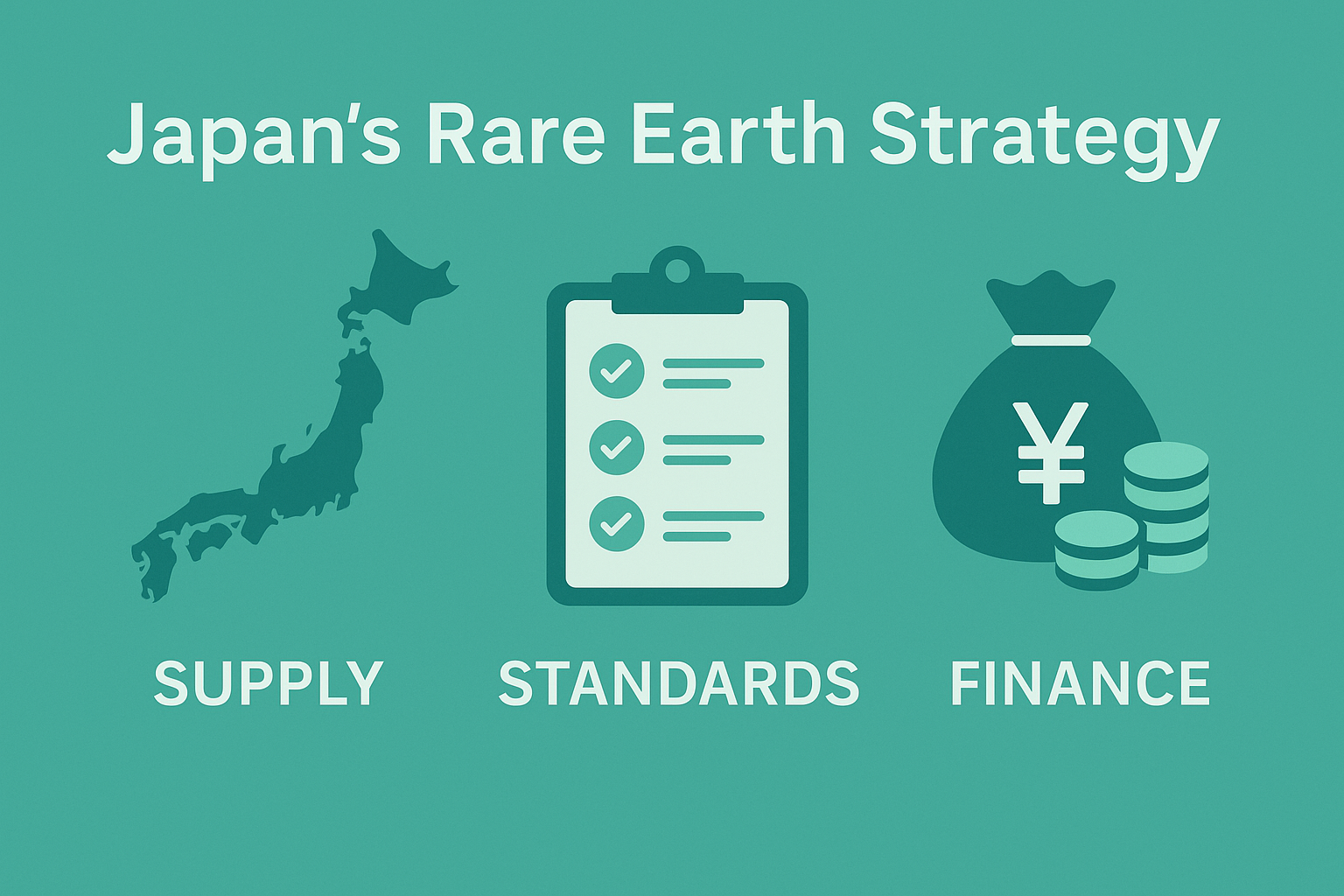A Strategic Response to China’s Export Controls and the New Resource Geopolitics
Executive Summary
In October 2025, the U.S. Department of Defense announced plans to procure up to $1 billion in critical minerals, marking a dramatic escalation in the strategic competition over resources between Washington and Beijing. This initiative, backed by $7.5 billion allocated under Trump’s One Big Beautiful Bill Act (OBBA), represents America’s urgent response to China’s unprecedented tightening of rare earth export controls. This report analyzes the multilayered implications for global supply chains, market dynamics, and strategic opportunities for allied nations, particularly Japan.
1. The Escalating Resource Confrontation
China’s Unprecedented Export Controls
On October 9, 2025, China’s Ministry of Commerce issued Announcement No. 61, implementing the strictest rare earth and permanent magnet export controls to date. This measure represents a qualitative shift in three dimensions.
First, China expanded restrictions to cover 12 of the 17 rare earth elements, adding holmium, erbium, thulium, europium, and ytterbium. Second, Beijing applied the Foreign Direct Product Rule (FDPR) for the first time—the same mechanism Washington has used against Chinese semiconductor firms—requiring licenses for exporting any products containing over 0.1% Chinese-sourced rare earths or manufactured using Chinese extraction, refining, or magnet-making technology.
Third, the timing was strategic. The announcement came just weeks before a planned Trump-Xi summit at the APEC forum in Gyeongju, South Korea, maximizing Beijing’s negotiating leverage. Starting December 1, 2025, companies affiliated with foreign militaries, including the U.S. military, will be largely denied export licenses.
Pentagon’s Emergency Procurement Plan
The Defense Logistics Agency (DLA) responded with an unprecedented procurement strategy:
- Cobalt: up to $500 million
- Antimony: $245 million (from U.S. Antimony)
- Tantalum: $100 million (from undisclosed U.S. supplier)
- Scandium: $45 million (from Rio Tinto and Illinois-based APL Engineered Materials)
The plan extends to rare earths, tungsten, bismuth, indium, and other metals not previously considered for national stockpiles. Notably, DLA is considering 3,000 tonnes of antimony—representing 12.5% of annual U.S. consumption—deemed “sufficient for industrial base mobilization in a national emergency.”
This procurement is supported by the OBBA Act, which allocates $2 billion for stockpile expansion through 2027, $5 billion for supply chain investments through 2029, and $500 million for a Pentagon credit program.
2. Market Disruption: Price Explosions and Structural Distortions
Antimony: From “Anti-Money” to Strategic Asset
The antimony market exemplifies the destructive impact of Chinese export controls. Prices surged from $5,500/tonne in 2019 to $57,000-60,000/tonne by mid-2025—an approximately 1,000% increase, described by Fastmarkets as “the steepest rally ever recorded” since price tracking began in 1980.
Chinese export restrictions created a stark two-tier pricing structure: international prices reach $57,000-60,000/tonne while domestic Chinese prices hover around $25,000-30,000/tonne. This bifurcation grants Chinese manufacturers decisive competitive advantages in flame retardants, lead-acid batteries, semiconductors, and military equipment.
China controls approximately 48% of global antimony production and 63% of U.S. antimony imports. The U.S. has not produced antimony domestically since 2001, when its last mine in Idaho closed. U.S. stockpiles were reportedly just 1,100 tonnes in 2003, against annual consumption of 22,000-24,000 tonnes. Chinese antimony exports have plummeted to one-third of previous levels.
Rare Earths: The Paradox of Oversupply and Strategic Scarcity
Rare earth markets face a different challenge: oversupply and price collapse. Neodymium-praseodymium (NdPr) prices fell from $66/kg in January 2024 to $55-57/kg by December, a 9% decline. Heavy rare earths suffered steeper drops: dysprosium fell 33% and terbium declined 22%.
Industry experts warn that if NdPr prices remain below $60/kg through 2030, approximately half of projected supply outside China will become economically unviable. At this price point, only eight rare earth projects beyond China are expected to break even on direct production costs. As industry veteran Constantine Karayannopoulos stated, “The rare earths industry is swimming in red ink.”
3. The Viability Challenge: Can Non-Chinese Supply Chains Be Built?
Doubts About Procurement Scale Feasibility
Market participants have expressed serious concerns about the Pentagon’s ambitious targets. Cristina Belda from Argus Media noted: “Market participants have been taken aback by the volumes requested by the DLA across several metals. Many consider the quantities to be unrealistic, especially within the proposed five-year timeframe. In most cases, the requested tonnages exceed the U.S.’s annual production and import levels.”
For example, DLA’s consideration of 222 metric tonnes of indium would severely strain non-Chinese supply chains, as indium is primarily produced as a byproduct of zinc refining with limited supply flexibility.
Alternative Supply Development: Progress and Constraints
U.S. Domestic Projects:
Perpetua Resources’ Stibnite Gold Mine in Idaho received final permits in January 2025, backed by $24.8 million in Department of Defense funding for environmental studies and $60 million for permitting. The U.S. Export-Import Bank expressed interest in providing up to $1.8 billion in financing. However, production won’t begin until 2028—offering no solution to near-term supply crises.
Australian Projects:
Lynas Corporation’s Mount Weld mine announced major expansion in late 2022, targeting 50% increase in NdPr production to 10,500 tonnes annually by 2025. Iluka Resources completed construction of a processing plant in 2022, with a fully-integrated rare earths refinery at Eneabba scheduled to begin production from 2027.
The Refining Bottleneck:
The fundamental challenge extends beyond mining. China controls over 90% of refining and processing capacity. Even antimony mined elsewhere is predominantly shipped to China for refining: 78% of Tajikistan’s antimony exports and 86% of Australia’s go to China.
To achieve true supply chain security, the U.S. must build entire vertically-integrated value chains from “mine to magnet.” This requires decades of time and tens of billions of dollars in investment.
4. Defense and National Security Implications
China’s new restrictions threaten critical defense systems including F-35 fighter jets, Virginia- and Columbia-class submarines, Tomahawk missiles, radar systems, Predator UAVs, and JDAM smart bombs. The U.S. already struggles to maintain production pace for these systems, while China scales up munitions manufacturing at an estimated rate five to six times faster than the United States.
Gracelin Baskaran, director of CSIS’s Critical Minerals Security Program, warns: “The new restrictions will only deepen these vulnerabilities, further widening the capability gap.”
The restrictions also open a new front in the semiconductor war, with case-by-case reviews required for rare earth exports intended for advanced chipmaking. A prominent Chinese industry observer suggested this indicates “China’s chip industry no longer faces research and development hurdles—those have already been solved.”
5. Strategic Implications for Japan
Japan’s Position: Vulnerabilities and Strengths
Japan faces severe vulnerabilities, importing over 95% of rare earths from China, similar to the EU’s 98% dependence. However, Japan possesses critical strengths: world-class rare earth separation and refining technology, advanced magnet manufacturing capabilities (Shin-Etsu Chemical, TDK, Hitachi Metals), and established resource diplomacy through JOGMEC and JBIC.
Strategic Recommendations
Short-term (1-3 years):
- Emergency Stockpile Enhancement: Expand national stockpiles to cover heavy rare earths, antimony, gallium, and germanium, targeting minimum six-month domestic consumption
- Strengthen Ties with Alternative Suppliers: Strategic partnerships with Australian firms (Lynas, Iluka, Arafura) and enhanced resource diplomacy with Kazakhstan, Mongolia, and Vietnam
- U.S. Strategic Alignment: Negotiate a comprehensive Japan-U.S. Critical Minerals Agreement, following models established with Canada and Australia
Medium-term (3-7 years):
- Domestic Refining Capacity: Construct integrated refining facilities to process imported ores, leveraging Japan’s technological superiority
- Asia-Pacific Critical Minerals Alliance: Lead establishment of a multilateral framework with the U.S., Australia, South Korea, India, and ASEAN nations to coordinate supply chain diversification
- Technology Innovation: Invest in reduced-rare-earth and rare-earth-free technologies, including advanced ferrite magnets and alternative permanent magnet compositions
Conclusion
The Pentagon’s $1 billion stockpile expansion represents more than emergency procurement—it signals a fundamental restructuring of global critical minerals markets. As resource nationalism enters a new era, countries like Japan face a strategic imperative: invest decisively in supply chain resilience or accept deepening dependence on China’s resource dominance.
The window for action is narrow. With most restrictions taking effect December 1, 2025, and alternative supply chains requiring years to establish, allied nations must coordinate unprecedented levels of investment, technology sharing, and strategic planning. The nation that masters critical minerals refining and processing—not just mining—will hold decisive advantages in the technological and military competition of the 21st century.


